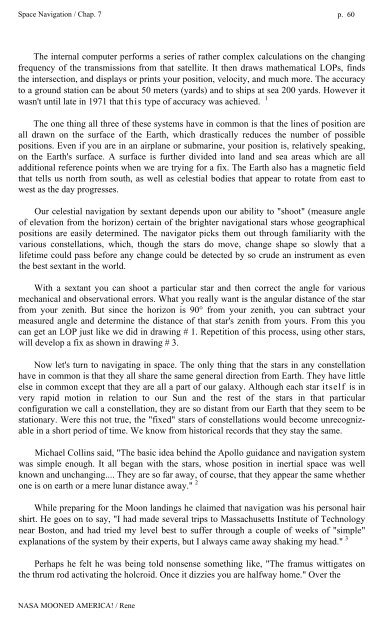Rene-NASA-Mooned-America
Rene-NASA-Mooned-America
Rene-NASA-Mooned-America
Create successful ePaper yourself
Turn your PDF publications into a flip-book with our unique Google optimized e-Paper software.
Space Navigation / Chap. 7 p. 60<br />
The internal computer performs a series of rather complex calculations on the changing<br />
frequency of the transmissions from that satellite. It then draws mathematical LOPs, finds<br />
the intersection, and displays or prints your position, velocity, and much more. The accuracy<br />
to a ground station can be about 50 meters (yards) and to ships at sea 200 yards. However it<br />
wasn't until late in 1971 that this type of accuracy was achieved. 1<br />
The one thing all three of these systems have in common is that the lines of position are<br />
all drawn on the surface of the Earth, which drastically reduces the number of possible<br />
positions. Even if you are in an airplane or submarine, your position is, relatively speaking,<br />
on the Earth's surface. A surface is further divided into land and sea areas which are all<br />
additional reference points when we are trying for a fix. The Earth also has a magnetic field<br />
that tells us north from south, as well as celestial bodies that appear to rotate from east to<br />
west as the day progresses.<br />
Our celestial navigation by sextant depends upon our ability to "shoot" (measure angle<br />
of elevation from the horizon) certain of the brighter navigational stars whose geographical<br />
positions are easily determined. The navigator picks them out through familiarity with the<br />
various constellations, which, though the stars do move, change shape so slowly that a<br />
lifetime could pass before any change could be detected by so crude an instrument as even<br />
the best sextant in the world.<br />
With a sextant you can shoot a particular star and then correct the angle for various<br />
mechanical and observational errors. What you really want is the angular distance of the star<br />
from your zenith. But since the horizon is 90° from your zenith, you can subtract your<br />
measured angle and determine the distance of that star's zenith from yours. From this you<br />
can get an LOP just like we did in drawing # 1. Repetition of this process, using other stars,<br />
will develop a fix as shown in drawing # 3.<br />
Now let's turn to navigating in space. The only thing that the stars in any constellation<br />
have in common is that they all share the same general direction from Earth. They have little<br />
else in common except that they are all a part of our galaxy. Although each star itself is in<br />
very rapid motion in relation to our Sun and the rest of the stars in that particular<br />
configuration we call a constellation, they are so distant from our Earth that they seem to be<br />
stationary. Were this not true, the "fixed" stars of constellations would become unrecognizable<br />
in a short period of time. We know from historical records that they stay the same.<br />
Michael Collins said, "The basic idea behind the Apollo guidance and navigation system<br />
was simple enough. It all began with the stars, whose position in inertial space was well<br />
known and unchanging.... They are so far away, of course, that they appear the same whether<br />
one is on earth or a mere lunar distance away." 2<br />
While preparing for the Moon landings he claimed that navigation was his personal hair<br />
shirt. He goes on to say, "I had made several trips to Massachusetts Institute of Technology<br />
near Boston, and had tried my level best to suffer through a couple of weeks of "simple"<br />
explanations of the system by their experts, but I always came away shaking my head." 3<br />
Perhaps he felt he was being told nonsense something like, "The framus wittigates on<br />
the thrum rod activating the holcroid. Once it dizzies you are halfway home." Over the<br />
<strong>NASA</strong> MOONED AMERICA! / <strong>Rene</strong>


